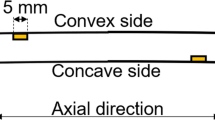Abstract
This study demonstrates the influence of residual stresses in steel wires on the stress relaxation losses. Standard stress relaxation tests were performed on four types of wire, all with the same mechanical properties but with different residual stresses. Surface residual stresses were measured by X-ray diffraction. The experimental results show that stress relaxation losses decrease as the value of surface tensile residual stresses decrease. The role, sometimes controversial, of initial pre-stretching and heat treatments on stress relaxation losses can also be understood in the light of the residual stresses induced during cold-drawing.
Résumé
Cette étude montre l'influence des contraintes résiduelles dans des câbles d'acier sur la perte de contrainte par relaxation. Des essais de relaxation ont été réalisés sur quatre types d'acier, avec les mêmes propriétés mécaniques et différentes contraintes résiduelles. Sur la surface, ces contraintes résiduelles ont été mesurées par diffraction de rayons X. Les résultats expérimentaux montrent que la perte de contrainte par relaxation diminue quand la valeur des contraintes résiduelles sur la surface s'affaiblit. Le rôle, parfois controverse, de la prédéformation et des traitements tehrmiques sur les pertes de contrainte par relaxation peut être expliqué par les contraintes résiduelles entraînées pendant le tréfilage.
Similar content being viewed by others
References
Lin, T.Y. and Burns, N.H., ‘Design of prestressed concrete structures’ (John Wiley and Sons, 1981).
Dumas, F., ‘Communication sur le relaxation des aciers de précontrainte’,Béton Précontraint 255–256 (March–April 1969) 594–607.
Van't Spijker, E., ‘The influence of prestretching on the relaxation properties of cold drawn wire for prestressed concrete’,Cement (January 1967).
Gifford, F.W., ‘Creep tests on prestressing steel’,Magazine of Concrete Research,15 (14) (1953).
Kajfasz, S., ‘Some relaxation tests on prestressing wire’,Magazine of Concrete Research 10 (39) (1958).
Magura, D., Sozen, M. and Siess, Ch., ‘A study of stress relaxation in prestressing reinforcement’,PCI Journal (1964). 13–57.
Spare, G.T., ‘Creep and relaxation of high strength steel-wires at room temperature’,Wire and Wire Products (October 1952).
Bannister, J.L., ‘Cold drawn prestressing wire’,The Structural Engineer (August 1953).
Mihailov, K. V., ‘Stress relaxation of high-tensile steel’, General report, Symposium FIP, Madrid (1968).
Atienza, J.M. Martínez, Mompeán, F.J., García-Hernández, M., Ruiz, J. and Elices, M., ‘Residual stresses in drawn wires: Numerical and experimental approach’ in ‘Fracture Mechanics Beyond 2000’ (A Neimitzet al Eds.) EMAS Pub. (2002) 113–120.
Zienkiewicz, O.C. and Taylor, R.L., ‘The Finite Element Method’ (McGraw-Hill, Inc., 1989).
Hibbitt, D., Karlsson, B. and Sorensen, P., ‘ABAQUS User's Manual. Version 5.8’ (1989).
Crook, A.J.L. and Hinton, E., ‘Comparison of 2d quadrilateral finite elements for plasticity problems’, in ‘Computational Plasticity’, Proceedings of the International Conference, Barcelona, April 1987 (Pineridge Press Limited, 1987) 181–195.
Bathe, K.J., Kojic, M. and Walczak, J., ‘Developments in methods for large strain elasto-plastic problems’ in ‘Computational Plasticity’, Proceedings of the International Conference, Barcelona, April 1989 (Pineridge Press Limited, 1989) 263–275.
Atienza, J.M., ‘Residual stresses in drawn, steel wires’, PhD Thesis (Polytechnique University of Madrid, 2001).
Hamada, T., Hirouchi, T. and Akiyama, M. ‘A numerical study of temperature in a fine high carbon steel wire subjected to high speed drawing’,Wire Journal International (May 2001) 86–92.
Author information
Authors and Affiliations
Additional information
Editorial note Prof. Manuel Elices is a RILEM Senior Member.
Rights and permissions
About this article
Cite this article
Atienza, J.M., Elices, M. Influence of residual stresses in the stress relaxation of cold drawn wires. Mat. Struct. 37, 301–304 (2004). https://doi.org/10.1007/BF02481675
Received:
Accepted:
Issue Date:
DOI: https://doi.org/10.1007/BF02481675




